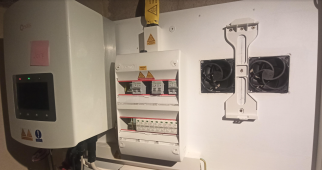jploh
New Member
My set up is a Solis hybrid inverter with 4 units of US3000C in parallel. In between the master battery and the inverter is a 125A MCB (Suntree SCB-125DC).
Recently, the MCB has been tripping and heats up from 3 to 3.5kW or higher. A portion of the cable close to the MCB is hot while the rest of the cables are in room temperature. The installer came today to inspect the MCB and it's suspected that one of the cables may have been tugged a bit. We still suspect that the MCB is underrated based on another thread here.
It would be 72A at 3.5kW 48V if the calculator I used is correct. Haven't been able to see on the inverter the actual charging current in amps - apart from the charge/discharge limit set to 148A.
I have a 5th unit to connect to the battery group, and possibly a 6th, so I'm wondering if the charging current could be lowered by putting the batteries in multi-group mode. If not, I guess there's no choice but to go with a higher capacity MCB? My inverter also says it's capped at 100A charging current. I tried lowering this but it may have a bug in the firmware as the change doesn't stick. It's also possible that the Pylontech is overriding this setting as described above.
We're also evaluating having a bus bar or terminal block and have multiple MCBs and divide the batteries.
Any advice would be appreciated.
Recently, the MCB has been tripping and heats up from 3 to 3.5kW or higher. A portion of the cable close to the MCB is hot while the rest of the cables are in room temperature. The installer came today to inspect the MCB and it's suspected that one of the cables may have been tugged a bit. We still suspect that the MCB is underrated based on another thread here.
It would be 72A at 3.5kW 48V if the calculator I used is correct. Haven't been able to see on the inverter the actual charging current in amps - apart from the charge/discharge limit set to 148A.
I have a 5th unit to connect to the battery group, and possibly a 6th, so I'm wondering if the charging current could be lowered by putting the batteries in multi-group mode. If not, I guess there's no choice but to go with a higher capacity MCB? My inverter also says it's capped at 100A charging current. I tried lowering this but it may have a bug in the firmware as the change doesn't stick. It's also possible that the Pylontech is overriding this setting as described above.
We're also evaluating having a bus bar or terminal block and have multiple MCBs and divide the batteries.
Any advice would be appreciated.




